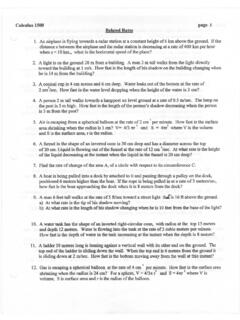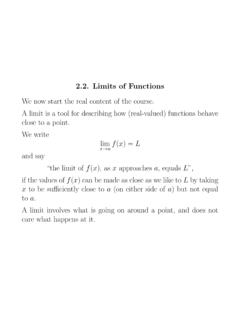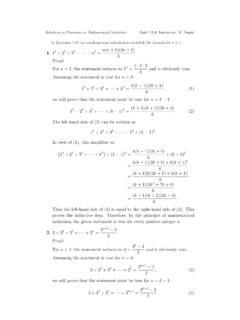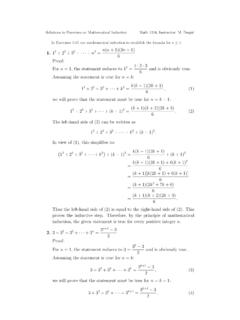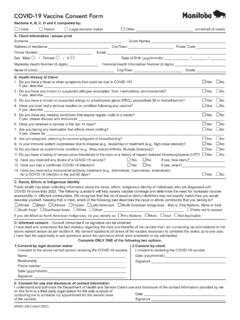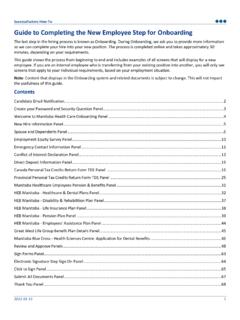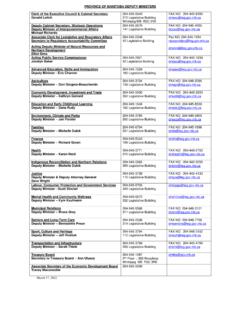Transcription of SECTION 3 - University of Manitoba
1 SECTION Complex Logarithm FunctionThe real logarithm function lnxis defined as the inverse of the exponential function y=lnxis the unique solution of the equationx=ey. This works becauseexis aone-to-one function; ifx16=x2, thenex16=ex2. This is not the case forez; we haveseen thatezis 2 i-periodic so that all complex numbers of the formz+2n iaremapped byw=ezonto the same complex number asz. To define the logarithmfunction, logz, as the inverse ofezis clearly going to lead to difficulties, and thesedifficulties are much like those encountered when finding the inverse function ofsinxin real-variable calculus. Let us proceed. We callwa logarithm ofz, and writew= logz,ifz=ew. To findwwe letw=u+vibe the Cartesian form forwandz=re ibe the exponential form forz.
2 When we substitute these intoz=ew,re i=eu+vi= to conditions , equality of these complex numbers implies thateu=roru=lnr,andv= = ,w=lnr+ i, and a logarithm of a complex numberzislogz=ln|z|+ (argz)i.( )We use ln only for logarithms of real numbers; log denotes logarithms of com-plex numbers using basee(and no other base is used).Because equation yields logarithms of every nonzero complex number, wehave defined the complex logarithm function. It is defined for allz6= 0, and becauseargzis determined only to a multiple of 2 , each nonzero complex number has aninfinite number of logarithms. For example,log (1 +i)=ln 2+( /4+2k )i=(1/2) ln2 + (8k+1) , to the complex number 1+i, the logarithm function assigns an infinite numberof values, log (1 +i)=(1/2) ln 2 + (8k+1) i/4.
3 They all have the same real part,but their imaginary parts differ by multiples of 2 . In other words, the logarithmfunction is a multiple-valued function; to each complex number in its domain, itassigns an infinity of log (2 3i) in Cartesian |2 3i|= 13, and arg (2 3i)=2k Tan 1(3/2),log (2 3i)=ln 13 + [2k Tan 1(3/2)]i=12ln 13 + [2k Tan 1(3/2)]i. Some of the properties of the real logarithm function have counterparts in thecomplex logarithm. For example, ifz=x+yi=re i, thenelogz=elnr+ i=elnre i=re i=z,( )(as should be expected from the definition of logz), and96 SECTION (ez)= log (ex+yi)=ln(ex)+(y+2k )i(kan integer)=x+yi+2k i=z+2k i.( )In real analysis the counterpart of this equation is logex=x.
4 Thez+2k on theright side of is a reflection of the facts that logzis multiple-valued and thelogarithm is the last operation on the left side of the iandz2=Re i, thenlog (z1z2) = log [rRe( + )i]=ln(rR)+( + +2p )i(pan integer)= (lnr+ i) + (lnR+ i)+2p logz1=lnr+( +2n )iand logz2=lnR+( +2m )i. Hence,log (z1z2) = (logz1 2n i) + (logz2 2m i)+2p i= logz1+ logz2+2(p n m) i= logz1+ logz2+2k i.( )Similarly,log(z1z2)= logz1 logz2+2k i.( )The last two results must be approached with care . Because the logarithm functionis multiple-valued, each equation must be interpreted as saying that given valuesfor the logarithm terms, there is a value ofkfor which the equation holds. It is alsopossible to write these equations in the formslog (z1z2)=logz1+ logz2,( )log(z1z2)= logz1 logz2.
5 ( )We interpret them as saying that given values for two of the logarithm terms, thereis a value of the third logarithm for which the equation is functions cannot be analytic. To see why, consider the deriva-tive of logz,ddzlogz= lim z 0log (z+ z) logz limit must exist, be unique, and be independent of the mode of approach of zto 0. But this is impossible if there is an infinity of possible choices for logzandfor log (z+ z) for each value of z. Thus, only single-valued functions can havederivatives. We therefore ask if it is possible to restrict the range of the logarithmfunction to obtain an analytic function; that is, can we make logzsingle-valued insuch a way that it will have a derivative.
6 The answer is yes, and there are manyways to do it. The most natural way to make logzsingle-valued is to restrict argzin equation to its principal value Argz. When this is done, we denote theresulting single-valued function byLogz=ln|z|+ (Argz)i, z6=0.( ) SECTION analytic function? The answer is yes in a suitably restricted see this, we note that at any point on the negative real axis, the imaginary partof Logzis a discontinuous function. Theorem implies therefore that Logzisdiscontinuous at points on the negative real axis, and Logzcannot be differentiablethereon. Suppose we consider the domain|z|>0, <Argz< . If we expressLogzin the formLogz=lnr+ i, < < ,partial derivatives of its real and imaginary parts are u r=1r, v =1, u =0, v r= these derivatives satisfy Cauchy-Riemann equations and are continuousin the domain|z|>0, <Argz< , it follows that Logzis an analytic functionin this domain.
7 According to formula , the derivative of Logzise i(1r)=1re i;that is,ddzLogz=1z.( )Thus, Logzis analytic in the domain|z|>0, <Argz< . It is definedfor allz6= 0, but analytic only in theaforementioned domain. Points on thenegative real axis andz= 0 are singu-larities of Logz, but they are not iso-lated singularities (Figure ).ImRezzzSingularities of LogFigure restriction of argzto Argzin the definition of Logzproduced a branch ofthe multiple-valued logarithm function called theprincipal branchof logz. Otherchoices for argzlead to different branches. For example, we could restrict argztoarg z. When this is done, we denote the resulting branch of the logarithm functionbylog z=ln|z|+ (arg z)i.
8 ( )These branches are analytic in anydomain that does not containz=0,the branch point, or points on thebranch cut, the half-line throughz= 0 making an angle of radianswith the positive real axis (Figure ).ImRezzBranch cut for logzffFigure real variable work, the notation logaxindicates thatais the base of thelogarithm function. This is not the case in complex function theory. Onlyeis used98 SECTION base for logarithms, and in log zindicates a particular branch of the Log( 1+ 3i), log /4( 1+ 3i), and log 3 /2( 1+ 3i) in complex number 1+ 3iis shown in Figure We see thatLog( 1+ 3i) = ln 2 + (2 /3)i,log /4( 1+ 3i) = ln 2 + (2 /3)i,log 3 /2( 1+ 3i)=ln2+( 4 /3)i. ImRezzi-1+323p,ImRezzBranch cutFigure cuts for the logarithm function need not be straight lines.
9 We couldstipulate that the branch cut of a branch of logzbe the parabolic curve in We simply agree that at each point on this curve, arguments ofzwill bespecified in a certain way, perhaps as 0<argz< /2, that arguments will increaseto the left of the curve, and that they will jump by 2 across the understand branches of a multiple-valued functionf, it is sometimes helpfulto visualize ranges of the branches in thew=f(z) plane. The three branches Logz,log0z, and log2 zof logzare illustrated in Figures Each branch mapsthez-plane (lessz= 0) onto a horizontal strip of width 2 .ImRezzImRewwpiwz=Logpi-pi-Figure branches of logzis reminiscent of the derivation of the inverse sinefunction in real-variable work.
10 The situations are very similar. Because sinxis2 -periodic, definingy= sin 1xwhenx= sinyresults in many values for sin values /2 Sin 1x /2 are chosen in order to create a single-valuedfunction. The difference in the two situations is that we almost always use principalvalues of Sin 1x; other choices are possible, but they are seldom used. In order thatlogzbe single-valued, we restrict argzto an interval of length 2 . This leads tobranches of logz, the principal branch Logz, but other branches as well. Becausewe have taken the effort to discuss other branches of logz, and even given some ofthem special notations (log z), the implication is that they are important. This isindeed true.
